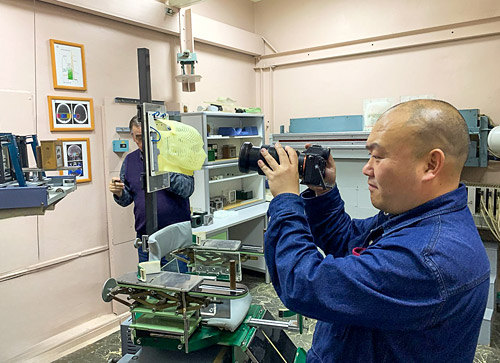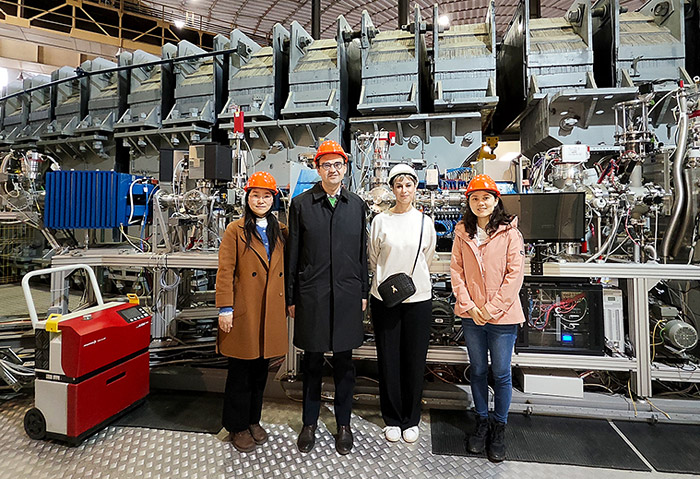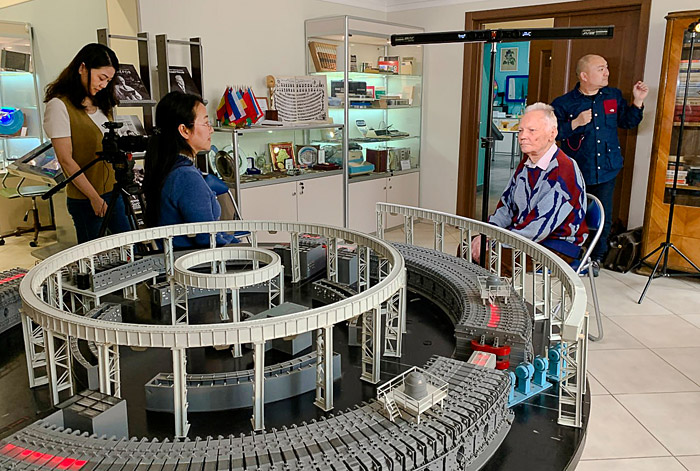
Electronic english version since 2022 |
The newspaper was founded in November 1957
| |
At the JINR Museum
Chinese documentary filmmakers at JINR
On 8-11 April, the film crew of the Central Chinese Newsreel and Documentary Film Studio, consisting of Zhang Li (director), Fulong Li (cameraman) and Qingyan Liu (scientific consultant, employee of the Institute of the History of Natural Sciences of the PRC Academy of Sciences) was at the Institute.

The group's goal was to film episodes for a documentary biographical film about Professor Wang Gangchang. The film will be in four parts, 25 minutes each and will cover the professor's entire life, including his childhood in rural China, his studies at Tsinghua University, his graduate studies in Germany with Lise Meitner and his subsequent work. He spent 1956-1960 in Dubna, being a member of the first Scientific Council, head of the national group of the People's Republic of China and at the same time head of the sector at LHE and later, vice-director of JINR. From 1960 to the mid-1970s, Wang Gangchang was one of the key developers of nuclear weapons in the PRC, afterwards, studied the issues of thermonuclear fusion and laser physics. He was an academician of the Chinese Academy of Sciences and one of the most influential figures in the development of China's scientific and technological policy during the reform period. Let us recall that the Chinese scientist is a co-author of the discovery of the antisigma-minus-hyperon particle.
JINR Deputy Chief Scientific Secretary Alexey Zhemchugov that accompanied the guests, said:
"The film is shot to mark the anniversary of the first atomic bomb test in China. The film is expected to be shown on China Central Television. There is hope that JINR employees will also have the opportunity to see it, surely, in translation."

He noted that the episodes were filmed at the JINR Museum, at the LHE site (3rd physics building, synchrophasotron control panel, synchrophasotron itself, 24-liter propane bubble chamber that was designed and used in experiments by the Wang Ganchang sector, the alley named after him); in the main administrative building of JINR, in the Conference Centre, in the Cultural Centre "Mir" (at the exhibition "Lovers of science" that is presented there, there is an artistic portrait of the scientist). The guests visited and filmed the DLNP phasotron, the memorial office of B.M.Pontecorvo and DLNP. In addition, the group photographed general views of Dubna, including Ratmino and the Moscow Sea area, as well as the facade of house 15 on Kurchatova Street, where Wang Ganchan lived at one time. The guests interviewed VBLHEP chief researcher V.A.Nikitin about his meetings with the Chinese scientist and about the general atmosphere at JINR at the turn of the 1950s and 1960s.
Alexey Zhemchugov also gave an interview about the work of Chinese employees at JINR, Wang Ganchang's contribution to the first experiments at the synchrophasotron, the discovery of the antisigma-minus-hyperon particle, as well as the role of the outstanding Chinese scientist in restoring scientific cooperation between JINR and China in the 1990-s.
For four days in the morning, the film crew learnt about the exhibition of the JINR Museum of History of Science and Technology and filmed there. As noted by the curator of the Museum's collections Kirill Kozubsky, the guests were particularly interested in the prototypes of the synchrocyclotron and synchrophasotron, portraits of the founding fathers of the Institute, the halls of history and new projects, the classroom laboratory and the design of the premises. They were very pleased that the museum cherishes the memory of Wang Ganchang and other Chinese scientists.

Summing up the visit of Chinese documentary filmmakers, Alexey Zhemchugov noted:
"Judging by the feedback from the crew members, the visit exceeded all expectations, their goals were achieved and their plans were exceeded. The film will be the first in China to show Wang Ganchang's Dubna period and perhaps the first film in which the billion Chinese television audience will see Dubna."
A.V.Butenko, E.I.Goryachkin, E.N.Dubovik, A.E.Zlotnikova, K.E.Kozubsky, K.P.Moisenz, M.S.Pilipenko, M.N.Sidorchuk, A.P.Cheplakov, S.V.Shvidky, E.R.Yamaleeva, employees of the Department of International Cooperation provided great assistance in organizing and implementing the filming.
The film crew expressed the hope that their next work would be a biographical film about Zhou Guangzhao and that they would again return to Dubna.
Nadezhda KAVALEROVA